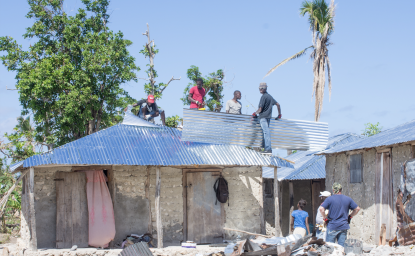What's Population Got to Do with It?
ESCP and GHI Program Associate Gib Clarke discusses the link between climate change and population in this Point of View column from the October 2006 issue of Centerpoint.
ESCP and GHI Program Associate Gib Clarke discusses the link between climate change and population in this Point of View column from the October 2006 issue of Centerpoint.
Most leading scientists agree that significant climate change is underway, due in part to human activity. Emissions of greenhouse gases (GHGs)—primarily from fossil-fuel intensive activities like driving, flying, air conditioning, and heating—are on the rise. Potential environmental consequences of climate change are well known, including melting polar ice, rising sea levels, and increasing intensity of hurricanes. Less discussed is the connection between population and climate change.
Every person contributes to climate change but not all at the same rate. The United States, with only 5 percent of the world's population, contributes nearly 25 percent of total GHGs, while the lowest-emitting 20 percent of the global population contributes only 2 percent. Despite this imbalance, global warming is by its very nature global—all citizens will suffer the consequences. And human beings are by their very nature human—all citizens will strive for better lives.
Developing countries, for example, quintupled GHG emissions from 1950 to 2000. China and India, rising economic powers, will increase their combined populations from 2.5 to 3 billion by 2050. Annual migration of nearly 3 million people from poor to wealthier countries will result in further emission increases.
Climate change also negatively affects human health. Higher global temperatures likely will lead to increased geographical dispersion and extended seasonality of tropical diseases, such as malaria and dengue fever. The World Health Organization attributes part of the recent increase in diarrhea and malaria to climate change.
So what can we do? If per capita GHG emissions were the only problem, the solution would simply be using less energy more efficiently. But the world's population is projected to reach between 7.3 and 11.2 billion by 2050, meaning more people will be producing more GHGs, ultimately putting humans and the earth's ecosystems at greater risk. Therefore, stabilizing the population, in developed and developing countries, must be a part of the solution.
The good news? Voluntary family planning programs are a relatively cheap investment. Coupled with education and empowerment of young girls, they have had profound success in reducing fertility rates. Not only do families around the world widely request these services, but also they can promote economic growth and political stability.
Combating climate change is a long-term consideration that requires action on all fronts. Reducing the demands humans place on the earth's atmosphere is incumbent on all 6+ billion of us—rich and poor alike.

The Environmental Change and Security Program (ECSP) explores the connections between environmental change, health, and population dynamics and their links to conflict, human insecurity, and foreign policy. Read more



